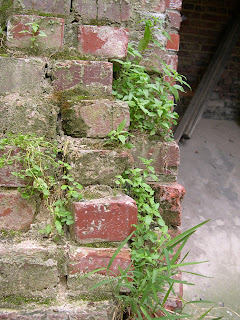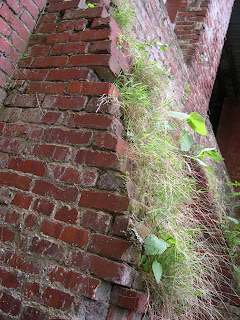I've always cringed a bit at some of the language Linda Montano uses to frame her endurance projects... (for example). The work itself has been so strong and meaningful for me that I've been able to overlook the bothersome language and construct my own critical apparatus around it.
I'm not so much bothered by the meaning or the ideas themselves, but how they've been articulated through mystical language. As with Ana Mendieta's performances being cast in the understandably discredited discourse of earth mothers and goddesses, there's so much more to the work than those narrow and clichéd explanations. For instance in this interview, which includes Tehching Hsieh, Montano talks more about some of the social aspects of her work – specifically the endurance project with Hsieh and a rope.
For some time now, I've wanted to write a bit about Endurance Art and some artists that I most admire – Linda Montano, Tehching Hsieh and On Kawara in particular. I just haven't been sure how to say all that's jumbling around in my head and relate it back to my own practice in a meaningful way. I considered just putting up some links to their work and then talking more about my own endurance processes. Links and process notes don't seem an adequate documentation of where my head has been recently, let alone my own progression through the ideas of endurance – from being a college student looking for art and meaning in the mundane and functional to a theory driven graduate student situating those same ideas within a critical discourse to a studio artist plowing through to deadlines, resting and repeating. And then... there's that pesky psychologizing and mysticizing language that sometimes attempts to explain acts of enduring art or enduring life.
Enduring life. I put those two words together because I'm intrigued by the ambiguous meaning of the phrase, which could mean a life that endures and is ongoing and self-perpetuating... or could also mean a life that must be suffered through. I see the phrase as a mirror to the acts of endurance art in that the acts are simultaneously poetic (even abstract) and drudgingly mundane as they are carried out over time. They endure only in their presence (as they're ongoing) and then finally only in their documentation. The very nature of endurance art is fleeting... non-enduring.
The endurance project may be a metaphoric, allegorical or abstracted representation of some interaction in the world or a demonstration that exposes (through the doing) the limits and parameters of that same material and social world. The acts also have potential to become a psychological "acting out" as in an hysterical manifestation of a personal or social ill, which before Freud would have been called religious or spiritual (in its more socially accepted forms and in the language of Montano) and called insane or "demon-possessed" in its less adaptable and more reviled forms.
But endurance art ultimately is significant because it is not an "acting out" but instead a conscious, willful and focused act. And here the language of spirituality comes back around because I'm reminded of the yogic practice of sadhana where willful and present intention and attention is key. Acts and practices mean something because they do take effort and because the effort hones a level of skill, strength and accomplishment with regular practice. As well, they're meaningful because they have a frame / focused attention / limits around them.
But acts of will can also be acts of letting go... letting go of a compulsion, habit or even a practice. For instance, for the workaholic, it could be a stop to whatever s/he's doing to make room for something other than the usual. The usual might even be that which has previously constituted a practice or an art (as mentioned above) or a project that has come to the end of its cycle.
Within any art practice are cycles of work, completion and letting go, but with endurance art these cycles (set in time) are as much a part of the content as any other element. They begin with the compulsive or repetitive action, the deliberate intention of setting a length of time and the act of enduring it. In this process... time, the spending of time and the passing of time are what become foregrounded. On Kawara demonstrates this most eloquently with his Date Paintings. And so, with his work, I end the pondering.
Thursday, December 20, 2007
Saturday, December 08, 2007
December First Friday (and Saturday)
Luckily, I recovered from the flu in time to attend First Friday. December is not the month where the Emporium Building events are so much about art as they are about the holiday celebrations and shopping. Nonetheless, we still had quite a few visitors in our studios interested in seeing and talking about art on both Friday and today.
At one point in the evening on Friday, we had no fewer than a half-dozen elves (from the parade on Gay Street, I’m assuming) gathered in our studio. Was quite the surreal moment for us and our other visitors.
And today, I had some interesting conversations with new visitors. Of particular note was Sandra Van Winkle whom I so enjoyed talking to. That’s the great thing about a public space like this, you never know who you might meet or the amazing conversations that might be sparked.
At one point in the evening on Friday, we had no fewer than a half-dozen elves (from the parade on Gay Street, I’m assuming) gathered in our studio. Was quite the surreal moment for us and our other visitors.
And today, I had some interesting conversations with new visitors. Of particular note was Sandra Van Winkle whom I so enjoyed talking to. That’s the great thing about a public space like this, you never know who you might meet or the amazing conversations that might be sparked.
Friday, November 30, 2007
avant-garde films & videos
I'm sick in bed. And what better way to while away the boring hours than with these. Enjoy.
Tuesday, November 13, 2007
Fig Leaf Loincloth
I just finished this piece yesterday:

Fig Leaf Loincloth
off-loom tapestry woven with bamboo and cotton fibers
It only took a little over a year to finish. See previous post.
Of course, I was working on other projects as well and would set it aside for months at a time. Still… what a labor-intensive process… and what a feeling of accomplishment to finally have it completed.
Here are a couple of process pics from the recent stage of work:
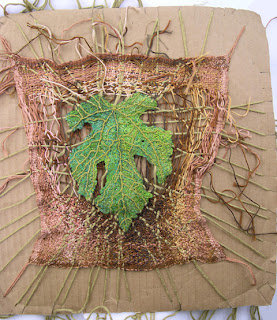
Front view, with second cardboard loom
See first cardboard loom / cartoon for the leaf from previous process post.
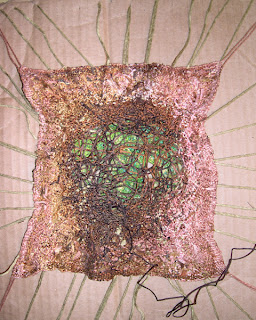
Back view

Fig Leaf Loincloth
off-loom tapestry woven with bamboo and cotton fibers
It only took a little over a year to finish. See previous post.
Of course, I was working on other projects as well and would set it aside for months at a time. Still… what a labor-intensive process… and what a feeling of accomplishment to finally have it completed.
Here are a couple of process pics from the recent stage of work:

Front view, with second cardboard loom
See first cardboard loom / cartoon for the leaf from previous process post.

Back view
Friday, November 09, 2007
November First Friday
Last Friday was First Friday. Busy. I spent much of it working on the string quilt commission that shipped out early this week. I also spent some time at A-1 LabArts where one of my videos was showing. I won't write more now as I have a busy weekend ahead and another deadline on Monday.
Thursday, October 18, 2007
Drawing as in walking as in mapping as in writing as in remembering
Here’s an interesting project by Chinese artist, Mengbo Feng. He uses his PDA and a GPS module to draw Chinese characters on city street maps as he walks.
Though the work is very different, the project reminded me of Wenda Gu’s work with Chinese characters and hair. Gu is a Chinese born conceptual artist living and working in N.Y. Several months ago he exhibited an installation that included curtains of hair with characters at UT’s Ewing Gallery as part of the group show Regeneration: Contemporary Chinese art from China and the US.
Gu also exhibited some of this work at the Hong Kong Museum of Art in 2006 as part of a dialogue with Mee-ping Leung, a friend and colleague of mine who came into CalArts the same year I did. We were both pursuing our MFAs when she began Memorize the Future, which grew in size over the years and went on to be exhibited in several venues. Both links show details of the installation which included hundreds of child-sized shoes molded from human hair.
Though the work is very different, the project reminded me of Wenda Gu’s work with Chinese characters and hair. Gu is a Chinese born conceptual artist living and working in N.Y. Several months ago he exhibited an installation that included curtains of hair with characters at UT’s Ewing Gallery as part of the group show Regeneration: Contemporary Chinese art from China and the US.
Gu also exhibited some of this work at the Hong Kong Museum of Art in 2006 as part of a dialogue with Mee-ping Leung, a friend and colleague of mine who came into CalArts the same year I did. We were both pursuing our MFAs when she began Memorize the Future, which grew in size over the years and went on to be exhibited in several venues. Both links show details of the installation which included hundreds of child-sized shoes molded from human hair.
Saturday, October 13, 2007
Quilt Coincidences
I went to my first meeting of the Smoky Mountain Quilters this weekend. ...lots of talented quilters... and a few odd coincidences.
The first coincidence was that I was invited to the meeting by one of the quiltwriters for this beautiful book on Gee's Bend Quilts right after I'd been studying it for a client who wanted me to create a similar (though still very different) string quilt from family clothing.
The second bit of coincidence was that the studio space beside me was almost rented a few days later by another artist who won an award for this piece in the last SMQ's show. This sheer quilt was a part of a recent exhibit at Ewing Gallery on the UT, Knoxville campus.
And third coincidence is that the Smoky Mountain Quilters were the group that sponsored the fiber award I received a few weeks ago at the Oak Ridge Open Show. The award was decided by the juror (and not SMQ) and was for this piece:
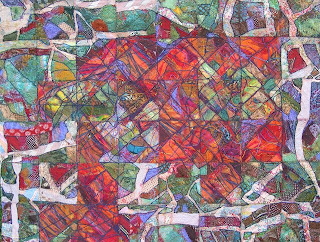 Los Angeles Aerial #3: Psychogeography of the crazy quilt (in the fashion of Jackson Pollock)
Los Angeles Aerial #3: Psychogeography of the crazy quilt (in the fashion of Jackson Pollock)
Not the best pic. As soon as the work comes down in early November, I'll have the piece professionally photographed.
The first coincidence was that I was invited to the meeting by one of the quiltwriters for this beautiful book on Gee's Bend Quilts right after I'd been studying it for a client who wanted me to create a similar (though still very different) string quilt from family clothing.
The second bit of coincidence was that the studio space beside me was almost rented a few days later by another artist who won an award for this piece in the last SMQ's show. This sheer quilt was a part of a recent exhibit at Ewing Gallery on the UT, Knoxville campus.
And third coincidence is that the Smoky Mountain Quilters were the group that sponsored the fiber award I received a few weeks ago at the Oak Ridge Open Show. The award was decided by the juror (and not SMQ) and was for this piece:
 Los Angeles Aerial #3: Psychogeography of the crazy quilt (in the fashion of Jackson Pollock)
Los Angeles Aerial #3: Psychogeography of the crazy quilt (in the fashion of Jackson Pollock)Not the best pic. As soon as the work comes down in early November, I'll have the piece professionally photographed.
Sunday, October 07, 2007
October First Friday
I spent a lot of time this First Friday going around to other galleries and watching a show at the new Black Box for Carpetbag Theater, which just opened across from our studio space. Sorry to those visitors I missed this month. Hope to see you next First Friday.
Thursday, September 27, 2007
Aerial Paintings
I finished these paintings:
 Random Pastoral Aerial #3: Flows and fissures
Random Pastoral Aerial #3: Flows and fissures
acrylic and water soluble oil on panel
 Random Pastoral Aerial #4: Pools and micro-climates
Random Pastoral Aerial #4: Pools and micro-climates
acrylic and water soluble oil on panel
I’ve changed the viewing orientation from previously.
 Random Pastoral Aerial #3: Flows and fissures
Random Pastoral Aerial #3: Flows and fissuresacrylic and water soluble oil on panel
 Random Pastoral Aerial #4: Pools and micro-climates
Random Pastoral Aerial #4: Pools and micro-climatesacrylic and water soluble oil on panel
I’ve changed the viewing orientation from previously.
Saturday, September 08, 2007
September First Friday
Last night was First Friday. I didn’t have much work up this month because I spent a lot of time on a commissioned fiber piece last week and, before that, re-stitching and stretching a canvas for another exhibit.
Since the commissioned work-in-progress was hanging on the corkboards in my studio, it got a lot of attention. People were very curious about all the fabrics and the possible history behind them. The best way to describe this piece, which is so unlike most of my work, would probably be: part Mondrian abstract and part Gee’s Bend string quilt. Out of respect for the client, I won’t show an image of the work at this point in construction.
Below is a pic of another stitched drawing. This map-like drawing is a detail of the new back of this aerial, Los Angeles Aerial #3: Psychogeography of the Crazy Quilt. Because the aerial was so heavy (layers and layers of canvas, fabrics, threads and yarns) I wasn’t really happy with the rod pocket for hanging, so I attached it to yet another piece of canvas and stretched it onto a canvas frame.
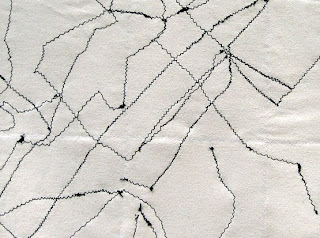
Since the commissioned work-in-progress was hanging on the corkboards in my studio, it got a lot of attention. People were very curious about all the fabrics and the possible history behind them. The best way to describe this piece, which is so unlike most of my work, would probably be: part Mondrian abstract and part Gee’s Bend string quilt. Out of respect for the client, I won’t show an image of the work at this point in construction.
Below is a pic of another stitched drawing. This map-like drawing is a detail of the new back of this aerial, Los Angeles Aerial #3: Psychogeography of the Crazy Quilt. Because the aerial was so heavy (layers and layers of canvas, fabrics, threads and yarns) I wasn’t really happy with the rod pocket for hanging, so I attached it to yet another piece of canvas and stretched it onto a canvas frame.

Monday, September 03, 2007
Some thoughts on feminism, fiber, media choice, contemporary art practices and labor
I’ve been pretty busy lately and, though I came to the conversation late, I did have every intention to respond to the Germaine Greer article, Making pictures from strips of cloth isn't art at all - but it mocks art's pretentions to the core, that has so many fiber artists and art quilters in an uproar, but have lost some of my interest in the task.
I will say that the first thing that struck me in reading the article is this: Did Greer miss post-modernism entirely? She’s upholding painting as an ideal even after its so-called “death” and death of any other material-based studio practice. To work with fibers, to work with paint, to work with any medium has not been necessary to constitute art for a very long time. And to claim any sort of permanence or immortality for the art object as criteria for legitimacy is so behind in the critical art discourse.... Surely Greer’s being ironic? Sadly, I don’t think so. Flippant maybe… glib, haphazard, ill-informed.
And there maybe is the irony… in the article’s ill-informed state, it shows itself to be a consequence / product of post-modernity (which seems to have escaped Greer) in that post-modernity has deflated the notion of expertise. Post-modernity affords a space for Greer where she can play the expert in fields where she is not. She or any of us have the freedom to write and pontificate about art (or science or whatever we choose) whether we’ve done our research about the subject or not. We are all equal to have our opinions. But still… some opinions are more informed than others just as some arguments are more valid than others.
Surely I don’t need to go into performance art, etc. or the material facts of all objects (no matter how mighty): they don’t survive forever. No matter how well protected, paint ages, it cracks – such is its history. Museums and conservationists help to preserve, but they do not try to turn back the effects of time on an old object, nor do they want to. Their jobs are to repair damage and prevent further destruction, not to make old paint look un-weathered and fresh. They reweave holes in old tapestries as well.
Regarding permanence and specifically media choice, Greer refers to Tracy Emin, whose sewn tent was “sadly burned.” Again, I’m not sure of Greer’s tone. Is she mourning the loss of a great object that mocks art, sarcastically calling it a loss as so many ignorant others who like to claim “that’s not art,” giving credibility to the patchwork of Edrica Huws by associating her with Emin or smartly showing the futility in hoarding the art object (as Emin’s tent was destroyed in an art storage facility)? Whatever the way, the object is gone as objects often become lost, destroyed, stolen, burned. (How many stories have we heard of “great pieces” being destroyed in studio fires?) That the piece existed in material form, that it was documented, that it fulfilled an idea and contributed to the discourse of art – this is where the meaning lies, not in the object's permanence.
To give privilege to an idea is not to say that this in any way does away with the cultural fact that an artist’s media choice and handling of materials always carry a history – personal, political and aesthetic – and each artist has a different set of histories and reasons for choosing his / her media to work through the ideas. For many, to chose fiber is a feminist statement that references a shared and inherited history of women’s work and, not only its "futility" as Greer recognizes, but its lack of commodifiable value. Historically, some labor is typically paid while other labor is neither paid nor recognized or, for that matter, even acknowledged as work. Certain labor lacks legitimacy and the proper sanctions from mostly male-dominated social institutions.
Might the "self-mocking" Greer writes about be related to art’s inherent uselessness and thus its often feminized role in a society (though the art heroes are, for the most part, male and the profession has historically been male-dominated)?
I’m not suggesting that any treatment of feminized materials (such as fabrics and fibers) is a “self-mocking” gesture though it can be or has been, espcially with so much irony being thrown around in the early 1990’s. Oftentimes a reference to the historically undervalued (i.e. women’s work) becomes a way to question what a society finds valuable. In that qualifying question, is the quantifiable… at some point, any artist who labors or, for that matter, any worker who labors must come to ask him or herself whether his / her work in particular or any labor for that matter (specifically the commodifiable and alienated kind) is futile. And then… embedded in that question of futility is its counter: Is all labor then potentially meaningful either intrinsically (meditative aspects, self-fulfillment, etc.) or extrinsically (financial gain, professional recognition, etc.) or both? That’s not to pretend that all work is equal in fulfillment or financial gain, but that some joy or meaning might be found in a variety of labor whether or not it is paid and “useful.”
And then there are those male artists who use fabric and fiber as their media. I won’t go into them either, though the point should be clear that they reference a history of women’s work as well.
I suppose it could very well be that fabric scraps are materials that are so over-determined and imbued with history that artists who use them are always at risk of “being misunderstood” or mis-categorized as the "wrong kind" of feminine. It is a fine line. And straddling this hybrid position where I'm sort of one thing and then kind of another, I often find I’m consciously shifting my weight from one side to the other of that fine line that divides the serious from the frivolous, the thoughtful from the sentimental and the powerful from the un-empowered.
I have no delusions that we are all able at all times to make equal choices with equal resources. We are not. We do not have the same career opportunities to do “important work” like developing cures for cancer or whatever constitutes “important [masculine] work” these days. The varying histories, privilege or lack of it, and our personal preferences make the difference in what is within our might or interest to pursue. Maybe we develop the compassion to recognize that some laborers / artists have more choices than others and the arrogance to hold ourselves to a higher standard by that recognition. Or maybe we hold to the compassion to let ourselves be where we are with our limitations and histories such that they are.
Ah, well... I ended up rambling on about it anyway.
So, thank you Germaine Greer, for generating conversation on this important topic as it concerns women, artists and those who labor.
I will say that the first thing that struck me in reading the article is this: Did Greer miss post-modernism entirely? She’s upholding painting as an ideal even after its so-called “death” and death of any other material-based studio practice. To work with fibers, to work with paint, to work with any medium has not been necessary to constitute art for a very long time. And to claim any sort of permanence or immortality for the art object as criteria for legitimacy is so behind in the critical art discourse.... Surely Greer’s being ironic? Sadly, I don’t think so. Flippant maybe… glib, haphazard, ill-informed.
And there maybe is the irony… in the article’s ill-informed state, it shows itself to be a consequence / product of post-modernity (which seems to have escaped Greer) in that post-modernity has deflated the notion of expertise. Post-modernity affords a space for Greer where she can play the expert in fields where she is not. She or any of us have the freedom to write and pontificate about art (or science or whatever we choose) whether we’ve done our research about the subject or not. We are all equal to have our opinions. But still… some opinions are more informed than others just as some arguments are more valid than others.
Surely I don’t need to go into performance art, etc. or the material facts of all objects (no matter how mighty): they don’t survive forever. No matter how well protected, paint ages, it cracks – such is its history. Museums and conservationists help to preserve, but they do not try to turn back the effects of time on an old object, nor do they want to. Their jobs are to repair damage and prevent further destruction, not to make old paint look un-weathered and fresh. They reweave holes in old tapestries as well.
Regarding permanence and specifically media choice, Greer refers to Tracy Emin, whose sewn tent was “sadly burned.” Again, I’m not sure of Greer’s tone. Is she mourning the loss of a great object that mocks art, sarcastically calling it a loss as so many ignorant others who like to claim “that’s not art,” giving credibility to the patchwork of Edrica Huws by associating her with Emin or smartly showing the futility in hoarding the art object (as Emin’s tent was destroyed in an art storage facility)? Whatever the way, the object is gone as objects often become lost, destroyed, stolen, burned. (How many stories have we heard of “great pieces” being destroyed in studio fires?) That the piece existed in material form, that it was documented, that it fulfilled an idea and contributed to the discourse of art – this is where the meaning lies, not in the object's permanence.
To give privilege to an idea is not to say that this in any way does away with the cultural fact that an artist’s media choice and handling of materials always carry a history – personal, political and aesthetic – and each artist has a different set of histories and reasons for choosing his / her media to work through the ideas. For many, to chose fiber is a feminist statement that references a shared and inherited history of women’s work and, not only its "futility" as Greer recognizes, but its lack of commodifiable value. Historically, some labor is typically paid while other labor is neither paid nor recognized or, for that matter, even acknowledged as work. Certain labor lacks legitimacy and the proper sanctions from mostly male-dominated social institutions.
Might the "self-mocking" Greer writes about be related to art’s inherent uselessness and thus its often feminized role in a society (though the art heroes are, for the most part, male and the profession has historically been male-dominated)?
I’m not suggesting that any treatment of feminized materials (such as fabrics and fibers) is a “self-mocking” gesture though it can be or has been, espcially with so much irony being thrown around in the early 1990’s. Oftentimes a reference to the historically undervalued (i.e. women’s work) becomes a way to question what a society finds valuable. In that qualifying question, is the quantifiable… at some point, any artist who labors or, for that matter, any worker who labors must come to ask him or herself whether his / her work in particular or any labor for that matter (specifically the commodifiable and alienated kind) is futile. And then… embedded in that question of futility is its counter: Is all labor then potentially meaningful either intrinsically (meditative aspects, self-fulfillment, etc.) or extrinsically (financial gain, professional recognition, etc.) or both? That’s not to pretend that all work is equal in fulfillment or financial gain, but that some joy or meaning might be found in a variety of labor whether or not it is paid and “useful.”
And then there are those male artists who use fabric and fiber as their media. I won’t go into them either, though the point should be clear that they reference a history of women’s work as well.
I suppose it could very well be that fabric scraps are materials that are so over-determined and imbued with history that artists who use them are always at risk of “being misunderstood” or mis-categorized as the "wrong kind" of feminine. It is a fine line. And straddling this hybrid position where I'm sort of one thing and then kind of another, I often find I’m consciously shifting my weight from one side to the other of that fine line that divides the serious from the frivolous, the thoughtful from the sentimental and the powerful from the un-empowered.
I have no delusions that we are all able at all times to make equal choices with equal resources. We are not. We do not have the same career opportunities to do “important work” like developing cures for cancer or whatever constitutes “important [masculine] work” these days. The varying histories, privilege or lack of it, and our personal preferences make the difference in what is within our might or interest to pursue. Maybe we develop the compassion to recognize that some laborers / artists have more choices than others and the arrogance to hold ourselves to a higher standard by that recognition. Or maybe we hold to the compassion to let ourselves be where we are with our limitations and histories such that they are.
Ah, well... I ended up rambling on about it anyway.
So, thank you Germaine Greer, for generating conversation on this important topic as it concerns women, artists and those who labor.
Wednesday, August 08, 2007
Daily Drawings and Water Witches
Here are a few new drawings from last week:
 Water Witch Running through Green
Water Witch Running through Green
pencil, machine stitching and fabric paint on paper
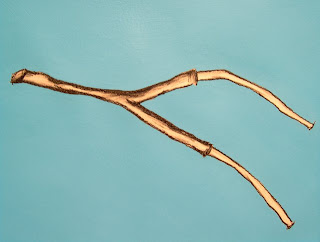 Water Witch Floating
Water Witch Floating
pencil, machine stitching and fabric paint on paper
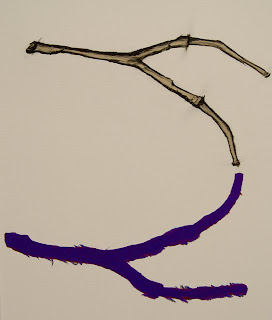 Water Witch Mirage
Water Witch Mirage
pencil, machine stitching and vintage fabric on paper
I’ve been working with this Water Witch motif for a few years now… since these L.A. Mirages from 2003. So long that they’ve taken on a bit of a persona and go about performing actions as any other character might.
Part of the initial reason for the birth of the water witch in my work was because Los Angeles was so dry and I was always craving and wanting to divine water and rain. So, the divining rod, also called the “water witch” seemed the likely trope for such urges.
The other reasons for the motif and my preference for the name “water witch” over "divining rod" were political. There is the more obvious governmental politics behind Los Angeles moving and stealing water from other locations, but I was more interested in acts of divining in terms of gender and art politics.
While I was working on the very clean photographic L.A. Mirages and similar video work (where my hands never got dirty), I began to step-up the other part of my materially-based practice of painting, drawing and fiber (what I’d moved away from in graduate school).
In moving back to materials and studio, I felt like (because I’d been trained to have this response) that I was doing something “witchy” and outside the mainstream of contemporary art practice. In other words, I was doing things that had become feminized within the field of art. I had turned myself into something of an “art witch” as I heretically toyed with ideas and materials and styles that were considered outside acceptable practice for someone of my background and training.
Despite the heaviness of all that… these are fun and playful little pieces for me.
 Water Witch Running through Green
Water Witch Running through Greenpencil, machine stitching and fabric paint on paper
 Water Witch Floating
Water Witch Floatingpencil, machine stitching and fabric paint on paper
 Water Witch Mirage
Water Witch Miragepencil, machine stitching and vintage fabric on paper
I’ve been working with this Water Witch motif for a few years now… since these L.A. Mirages from 2003. So long that they’ve taken on a bit of a persona and go about performing actions as any other character might.
Part of the initial reason for the birth of the water witch in my work was because Los Angeles was so dry and I was always craving and wanting to divine water and rain. So, the divining rod, also called the “water witch” seemed the likely trope for such urges.
The other reasons for the motif and my preference for the name “water witch” over "divining rod" were political. There is the more obvious governmental politics behind Los Angeles moving and stealing water from other locations, but I was more interested in acts of divining in terms of gender and art politics.
While I was working on the very clean photographic L.A. Mirages and similar video work (where my hands never got dirty), I began to step-up the other part of my materially-based practice of painting, drawing and fiber (what I’d moved away from in graduate school).
In moving back to materials and studio, I felt like (because I’d been trained to have this response) that I was doing something “witchy” and outside the mainstream of contemporary art practice. In other words, I was doing things that had become feminized within the field of art. I had turned myself into something of an “art witch” as I heretically toyed with ideas and materials and styles that were considered outside acceptable practice for someone of my background and training.
Despite the heaviness of all that… these are fun and playful little pieces for me.
Labels:
daily drawings,
feminism,
mirages,
stitched drawings,
water,
water witch
Tuesday, August 07, 2007
August First Friday: Shoebox Sculpture, Aaron McIntosh and the new studio orientation
We had another excellent First Friday last week with the chance to talk to several people we hadn’t seen in a while and the opportunity to meet more cool new folks. I only looked into a couple of other galleries by recommendation from some of my visitors who referred me next door to the Shoebox Sculpture exhibit at UT’s Downtown Gallery and across the way to see the excellent work of Aaron McIntosh at 1010.
I didn’t have much time or room (the gallery was pretty crowded) to spend with the Shoebox Sculptures at the Downtown Gallery, so I’ll have to go back over the next few days. One of the sculptures really leapt out at me though: Brooklyn artist John Drury’s Shoe Nut… a lovely little piece constructed from the tips of two wingtip shoes.
Continuing with the men’s wear theme...
Across the way at 1010, fiber artist Aaron McIntosh was exhibiting some stitched target / breast-like imagery similar to this work where he’s mentioned in this issue of Fiberarts Magazine as a young talent to watch. Click on his name to see the work. He is definitely a rare and exceptional talent.
I was most taken with an image on one of Aaron’s cards from a previous show. The quilted piece is titled Family Tree 1 and is constructed from men’s pants fabrics, romance novel pages, cotton batting and thread stitching. I couldn’t find a link to the completed piece, but here’s a picture of the artist working on it. You can get a good sense of how the whole thing looks with these paired and singular egg-like textual parts peeking through (with what looks like reverse appliqué) from the somber grey, taupe, black, etc. of men’s woolens.
For more of Aaron McIntosh’s work scroll down to his name and click on images.
Back across the street at my open studio... here’s a pic of the new set-up since I’ve rotated into my new space:
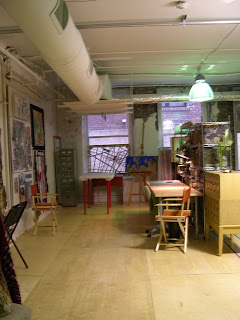 Barely got this pulled together before First Friday. I’m still not completely moved in. The flowers to the right were a gift from fiber artist Judi Gaston in celebration of the new space. Judi wasn’t able to be at First Friday because she was opening another exhibit at Aerial Gallery in Asheville.
Barely got this pulled together before First Friday. I’m still not completely moved in. The flowers to the right were a gift from fiber artist Judi Gaston in celebration of the new space. Judi wasn’t able to be at First Friday because she was opening another exhibit at Aerial Gallery in Asheville.
I didn’t have much time or room (the gallery was pretty crowded) to spend with the Shoebox Sculptures at the Downtown Gallery, so I’ll have to go back over the next few days. One of the sculptures really leapt out at me though: Brooklyn artist John Drury’s Shoe Nut… a lovely little piece constructed from the tips of two wingtip shoes.
Continuing with the men’s wear theme...
Across the way at 1010, fiber artist Aaron McIntosh was exhibiting some stitched target / breast-like imagery similar to this work where he’s mentioned in this issue of Fiberarts Magazine as a young talent to watch. Click on his name to see the work. He is definitely a rare and exceptional talent.
I was most taken with an image on one of Aaron’s cards from a previous show. The quilted piece is titled Family Tree 1 and is constructed from men’s pants fabrics, romance novel pages, cotton batting and thread stitching. I couldn’t find a link to the completed piece, but here’s a picture of the artist working on it. You can get a good sense of how the whole thing looks with these paired and singular egg-like textual parts peeking through (with what looks like reverse appliqué) from the somber grey, taupe, black, etc. of men’s woolens.
For more of Aaron McIntosh’s work scroll down to his name and click on images.
Back across the street at my open studio... here’s a pic of the new set-up since I’ve rotated into my new space:
 Barely got this pulled together before First Friday. I’m still not completely moved in. The flowers to the right were a gift from fiber artist Judi Gaston in celebration of the new space. Judi wasn’t able to be at First Friday because she was opening another exhibit at Aerial Gallery in Asheville.
Barely got this pulled together before First Friday. I’m still not completely moved in. The flowers to the right were a gift from fiber artist Judi Gaston in celebration of the new space. Judi wasn’t able to be at First Friday because she was opening another exhibit at Aerial Gallery in Asheville.
Labels:
art quilts,
community,
fiber artists,
first friday,
studio
Tuesday, July 24, 2007
Instances of Resistance and Daily Drawings
I haven’t had much time to get around and visit the galleries since teaching has taken up most of my recent days. The teaching has been good because it reminds me of the importance of foundational skills such as drawing and painting. The two are so much a part of my underlying experience that I don’t even think of them as separate skills in their own right. I rarely practice pure drawing or painting, and yet I often take for granted the ability to call upon them at will.
So… teaching has prompted me to uncomplicated my process a bit and do something I’ve wanted to do for several months: daily drawings. I’ve also wanted to combine the daily drawings with the Instances of Resistance project, but wasn’t quite sure where I would take it. Until a few days ago, I only knew that I wanted these isolated pieces of rogue plant-life to have a simple, candy-like preciousness to them. (I guess that would be the nostalgia I tend to play around with.) I also wanted the feral plants pushing their way up through the cracks of human construction to have an almost caricature persona and to leave a graffiti-like imprint on the ruins they inhabit.
Below are some drawings from the last few days (digital photo prints on Bristol Board that I’ve drawn over with an 8B pencil):
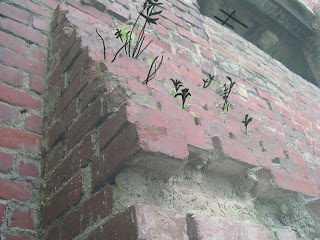 Instance graffiti #4: 11 feral plants, 8 twigs and 1 cross-beam in brick ruin
Instance graffiti #4: 11 feral plants, 8 twigs and 1 cross-beam in brick ruin
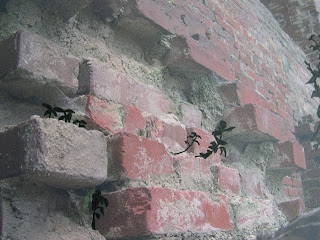 Instance graffiti #3: 9 feral plants in brick ruin
Instance graffiti #3: 9 feral plants in brick ruin
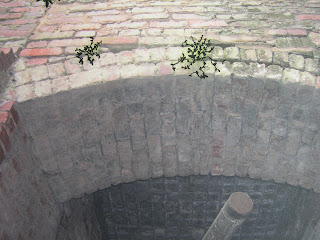 Instance graffiti #2: 3 feral plants above archway
Instance graffiti #2: 3 feral plants above archway
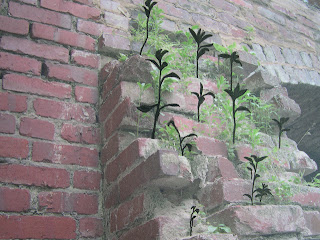 Instance graffiti #1: 12 feral plants among others in brick ruin
Instance graffiti #1: 12 feral plants among others in brick ruin
So… teaching has prompted me to uncomplicated my process a bit and do something I’ve wanted to do for several months: daily drawings. I’ve also wanted to combine the daily drawings with the Instances of Resistance project, but wasn’t quite sure where I would take it. Until a few days ago, I only knew that I wanted these isolated pieces of rogue plant-life to have a simple, candy-like preciousness to them. (I guess that would be the nostalgia I tend to play around with.) I also wanted the feral plants pushing their way up through the cracks of human construction to have an almost caricature persona and to leave a graffiti-like imprint on the ruins they inhabit.
Below are some drawings from the last few days (digital photo prints on Bristol Board that I’ve drawn over with an 8B pencil):
 Instance graffiti #4: 11 feral plants, 8 twigs and 1 cross-beam in brick ruin
Instance graffiti #4: 11 feral plants, 8 twigs and 1 cross-beam in brick ruin Instance graffiti #3: 9 feral plants in brick ruin
Instance graffiti #3: 9 feral plants in brick ruin Instance graffiti #2: 3 feral plants above archway
Instance graffiti #2: 3 feral plants above archway Instance graffiti #1: 12 feral plants among others in brick ruin
Instance graffiti #1: 12 feral plants among others in brick ruin
Sunday, July 08, 2007
July First Friday
First Friday was a couple of days ago and was one of the most enjoyable. I always have fun, but this one in particular was exceptional. Met a lot of cool people and had some great conversations. Thanks to everyone who stopped by.
Unfortunately, I was so busy socializing that I didn’t get time to move around the galleries, look at all the art and talk to the artists. Hopefully, I’ll be able to see some of that work later in the week.
Unfortunately, I was so busy socializing that I didn’t get time to move around the galleries, look at all the art and talk to the artists. Hopefully, I’ll be able to see some of that work later in the week.
Wednesday, July 04, 2007
Aerial Fragments
Below is a detail of what was originally a 5' x 6' canvas that I dyed by pouring fabric paints and fiber dyes onto raw canvas and then filling with fabric paint in between the pours. The process and rationale is similar to what I did here. I finished painting and dyeing the canvas in 2005, but have been periodically cropping and tearing smaller works from the original canvas (the scale and proportions of which needed some alteration). This is in fact a detail of one of the smaller fragments. I'm still cropping and playing with the proportions. Sometimes I'll begin this type of alteration by cropping photos in Photoshop.
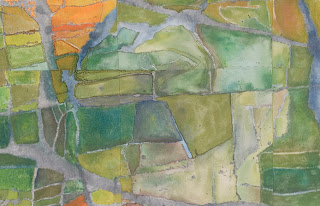
West Coast Fragment #7: Water and concrete, 2005-07
30" x 30" (detail, 15" x 24")
Dyed and painted canvas with hand and machine stitching
And here are some of the earlier fragments torn from the same large canvas.

West Coast Fragment #7: Water and concrete, 2005-07
30" x 30" (detail, 15" x 24")
Dyed and painted canvas with hand and machine stitching
And here are some of the earlier fragments torn from the same large canvas.
Tuesday, June 26, 2007
Walking and Remembering
I just uploaded some work from 2004 to the gallery. Here’s the first in the series:

Memory Walk #1, 2004
10” x 12” drawing stitched with hand-dyed cotton yarn on raw canvas
Every evening for years my partner, Frank, and I would take the same walk around the Los Feliz neighborhood in Los Angeles. The walk took about an hour or hour and a half, depending on whether we added an extra loop. We would begin at the edge of the neighborhood where Silverlake and Los Feliz meet at the Rowena reservoir and head straight up the steep end of St. George to the nunnery at the top of the hill, arc back down to Rowena and into Los Feliz where we would wind around until we made our way back to the point where we started.
Most walks included wildlife spotting, usually skunks, but also coyotes and raccoons and the occasional owl. The ritual was playful and heady, a time for us to process our day and figure out problems we might be having with our respective projects.
I miss the walks. I miss the neighborhood. I miss the ritual and the meaning and structuring it gave both of us. But for everything there is an exchange; and now we have bike rides in the morning (as we live right off a shady greenway). And the bike rides have their own delight and meaningfulness and wildlife: blue herons, geese with their goslings and turtles. Still, I miss the walks.
So in thinking on these things, I pulled out these stitched drawings and have been sewing them together to form one large piece.
Here’s the last piece in the initial series and part of the statement posted in the gallery:
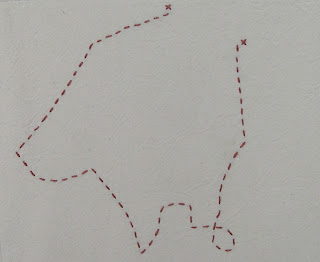
Memory Walk #9, 2004
Xs mark the beginning and ending point, which never quite match up because I’m re-walking the route in my mind as I stitch. Each memory is different with stretches of road being a bit longer or shorter and with every twist and turn being at a slightly different angle.
Sometimes the actual walks included an extra loop depending on the evening and my and my walking partner’s energy level. So some memories have the loop and some don’t.
In doing this mapping project, I was drawing a connection between sequential activities (walking, stitching, remembering, narrating) and was bringing a time-based element and the body back into the 2-D map, which is usually static. I was also marking evidence of how repetition or re-telling of a story, even in stitches, engrains a pattern and molds the map to a more ideal (or nostalgic) likeness to the "original" territory.

Memory Walk #1, 2004
10” x 12” drawing stitched with hand-dyed cotton yarn on raw canvas
Every evening for years my partner, Frank, and I would take the same walk around the Los Feliz neighborhood in Los Angeles. The walk took about an hour or hour and a half, depending on whether we added an extra loop. We would begin at the edge of the neighborhood where Silverlake and Los Feliz meet at the Rowena reservoir and head straight up the steep end of St. George to the nunnery at the top of the hill, arc back down to Rowena and into Los Feliz where we would wind around until we made our way back to the point where we started.
Most walks included wildlife spotting, usually skunks, but also coyotes and raccoons and the occasional owl. The ritual was playful and heady, a time for us to process our day and figure out problems we might be having with our respective projects.
I miss the walks. I miss the neighborhood. I miss the ritual and the meaning and structuring it gave both of us. But for everything there is an exchange; and now we have bike rides in the morning (as we live right off a shady greenway). And the bike rides have their own delight and meaningfulness and wildlife: blue herons, geese with their goslings and turtles. Still, I miss the walks.
So in thinking on these things, I pulled out these stitched drawings and have been sewing them together to form one large piece.
Here’s the last piece in the initial series and part of the statement posted in the gallery:

Memory Walk #9, 2004
Xs mark the beginning and ending point, which never quite match up because I’m re-walking the route in my mind as I stitch. Each memory is different with stretches of road being a bit longer or shorter and with every twist and turn being at a slightly different angle.
Sometimes the actual walks included an extra loop depending on the evening and my and my walking partner’s energy level. So some memories have the loop and some don’t.
In doing this mapping project, I was drawing a connection between sequential activities (walking, stitching, remembering, narrating) and was bringing a time-based element and the body back into the 2-D map, which is usually static. I was also marking evidence of how repetition or re-telling of a story, even in stitches, engrains a pattern and molds the map to a more ideal (or nostalgic) likeness to the "original" territory.
Monday, June 04, 2007
June First Friday and meandering with neckties
This weekend was the First Friday art walk and the group show for the Arts and Culture Alliance. I finally finished the large fiber aerial and included it in the show. Here’s a photo:

Los Angeles Aerial #3: Psychogeography of the Crazy Quilt
mixed fibers and fabric on canvas, 3' x 4'
The photo isn’t the best quality because I haven’t had the final piece professionally photographed yet, but you can still see how it has changed from earlier. I’ve sharpened the edges and drawn lines with machine-couched dark yarns… and I’m very pleased with the results.
This piece is made up mostly of men's neckties that I wove into a thick fabric, hand-stitched together with other hand-dyed fabrics, cut into squares, reconstructed into a grid, stitched to canvas and drew over with machine stitching. I invested months of meandering, free-associative stitching into this painting / crazy quilt. Both the long process and the final form reflect my personal response to the flows and restrictions of everyday life (which involves so much driving) in Los Angeles.
In another associate gesture, I pulled out the Necktie Ballgown (because it’s made of men’s ties as well) to do some repairs and exhibit it on the dressform in my studio. I’ve been replacing the few silk ties (which have begun to fray and rot as silk does) with more sturdy, thick polyester ties from the 1970s. I love these ties for all their patterns and brilliant colors, which give them a particularly peacock-y quality... and since I've taken this masculine trope and given it this feminized form, I find the 70s era ties even more appropriate to the project.
First Friday visitors loved seeing this fun piece, and one brave person even wanted to try it on and feel its weight as she strolled through the galleries both upstairs and down. Here’s a picture that Frank took on his cellphone of the beautiful Victoria Lenne wearing the Necktie Ballgown. Several people said that the piece came to life with her wearing it... apparently Freida the dressform just doesn’t do the dress justice. Thank you, Victoria, for your boldness and your delight in wearing the Necktie Ballgown.
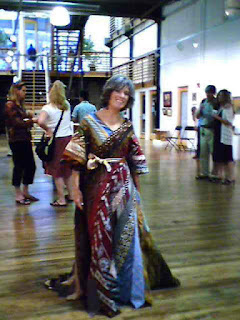 Victoria Lenne is a painter. Here’s a website (she says is a bit out of date) where you can see some of her work.
Victoria Lenne is a painter. Here’s a website (she says is a bit out of date) where you can see some of her work.

Los Angeles Aerial #3: Psychogeography of the Crazy Quilt
mixed fibers and fabric on canvas, 3' x 4'
The photo isn’t the best quality because I haven’t had the final piece professionally photographed yet, but you can still see how it has changed from earlier. I’ve sharpened the edges and drawn lines with machine-couched dark yarns… and I’m very pleased with the results.
This piece is made up mostly of men's neckties that I wove into a thick fabric, hand-stitched together with other hand-dyed fabrics, cut into squares, reconstructed into a grid, stitched to canvas and drew over with machine stitching. I invested months of meandering, free-associative stitching into this painting / crazy quilt. Both the long process and the final form reflect my personal response to the flows and restrictions of everyday life (which involves so much driving) in Los Angeles.
In another associate gesture, I pulled out the Necktie Ballgown (because it’s made of men’s ties as well) to do some repairs and exhibit it on the dressform in my studio. I’ve been replacing the few silk ties (which have begun to fray and rot as silk does) with more sturdy, thick polyester ties from the 1970s. I love these ties for all their patterns and brilliant colors, which give them a particularly peacock-y quality... and since I've taken this masculine trope and given it this feminized form, I find the 70s era ties even more appropriate to the project.
First Friday visitors loved seeing this fun piece, and one brave person even wanted to try it on and feel its weight as she strolled through the galleries both upstairs and down. Here’s a picture that Frank took on his cellphone of the beautiful Victoria Lenne wearing the Necktie Ballgown. Several people said that the piece came to life with her wearing it... apparently Freida the dressform just doesn’t do the dress justice. Thank you, Victoria, for your boldness and your delight in wearing the Necktie Ballgown.
 Victoria Lenne is a painter. Here’s a website (she says is a bit out of date) where you can see some of her work.
Victoria Lenne is a painter. Here’s a website (she says is a bit out of date) where you can see some of her work.
Saturday, May 19, 2007
Instances of Resistance are springing up everywhere
Tuesday, May 08, 2007
May First Friday and Shibori
May First Friday was a few days ago. The evening was pretty mellow with less of a turnout than usual, as we had expected it would be… partly due to rainy weather and other events in the city this weekend. I was exhausted from a long month of over-working and didn’t get around to see much of the art in the other galleries, but we had a great evening and talked to some interesting people nonetheless.
Since I set up my first studio in 1990, I’ve maintained a functional line to my practice where I make affordable, custom pieces (mostly clothing) available to a broader audience. I don’t do that much clothing anymore, unless it’s a custom piece, but I am beginning to make fabrics for the home. Right now, I’m using Shibori techniques to bleach dark fabrics – indigos, blacks, reds and greens.
On First Friday, I showed some of the new Shibori pieces (mostly floor-length curtain panel pairs that mirror one another) to a great response from our studio visitors. Unfortunately, I haven’t photographed any of that work yet. Once I get things photographed and a few other things completed, I plan to set up a small on-line shop where I’ll be selling functional items made of Shibori fabrics. I’m really proud of these beautiful pieces and am eager to get them out there. Pictures to follow soon.
Since I set up my first studio in 1990, I’ve maintained a functional line to my practice where I make affordable, custom pieces (mostly clothing) available to a broader audience. I don’t do that much clothing anymore, unless it’s a custom piece, but I am beginning to make fabrics for the home. Right now, I’m using Shibori techniques to bleach dark fabrics – indigos, blacks, reds and greens.
On First Friday, I showed some of the new Shibori pieces (mostly floor-length curtain panel pairs that mirror one another) to a great response from our studio visitors. Unfortunately, I haven’t photographed any of that work yet. Once I get things photographed and a few other things completed, I plan to set up a small on-line shop where I’ll be selling functional items made of Shibori fabrics. I’m really proud of these beautiful pieces and am eager to get them out there. Pictures to follow soon.
Tuesday, April 24, 2007
Linda Montano and Tehching Hsieh interview link
My influences have been—my grandmother, who took out her false teeth at most family gatherings and sang, "If I Had the Wings of an Angel"; my mother, who is a painter; Lily Tomlin; Marcel Duchamp; Eva Hesse, and St. Theresa of Avila.
Linda Montano
Quoted from this interview about her year long endurance project with Tehching Hsieh and a rope.
Linda Montano
Quoted from this interview about her year long endurance project with Tehching Hsieh and a rope.
Monday, April 09, 2007
The Gallery and some earlier work
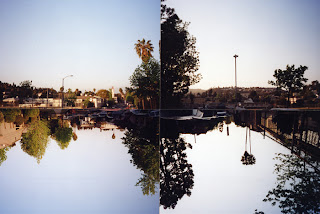 L.A. Mirage 01
L.A. Mirage 01 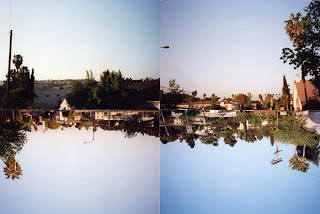 L.A. Mirage 04
L.A. Mirage 04Above are a couple of images from a series I did in 2003. I just updated this page on my gallery blog with the series of 7 mirages and thought I'd copy a couple over to here because I like this series so much... and sometimes it's fun to visit older work (sometimes less so).
I printed these photos on different media from waxed paper to vellum to photo paper, but none to satisfactory results. I intend to print them on photo fabric and stitch them together where they join, but have yet to do that. Until then, here they are digitally, which is how they continue to exist... and maybe all they ever need to be.
I explain the work more on the gallery page.
Sunday, April 08, 2007
April First Friday and Random Aerials
I showed 10 Aerials at this month's First Friday, including some newer paintings with the ones I've been working on over the past several months.
 Random Aerial #1: Water, desert and ocean with no city
Random Aerial #1: Water, desert and ocean with no city
mixed-media on panel
48" x 56"
Above is one of the older pieces and below one of the newer (and possibly still in-progress) pieces. Both are part of the Random Aerial series. On the painting below, I didn't use any topographical media (fabric or paper) to sculpt and give dimension to the surface as I did with the top piece.
 Random Aerial View #3: Pastoral Kaleidoscope
Random Aerial View #3: Pastoral Kaleidoscope
mixed-media on panel
24' x 24'
The Pastoral Kaleidoscope is an abstracted agrarian landscape that suggests dynamic motion though the patterning is flattened and the viewer's orientation to the picture plane is static / perpendicular.
Here's a side view of the gallery box construction:

I constructed all the boxes myself from oak... hand mitered the corners, secured the plywood panel and finished the wood with a natural stain and buffed wax. The panels themselves are finished with 6 coats of sanded and damp burnished gesso.
 Random Aerial #1: Water, desert and ocean with no city
Random Aerial #1: Water, desert and ocean with no citymixed-media on panel
48" x 56"
Above is one of the older pieces and below one of the newer (and possibly still in-progress) pieces. Both are part of the Random Aerial series. On the painting below, I didn't use any topographical media (fabric or paper) to sculpt and give dimension to the surface as I did with the top piece.
 Random Aerial View #3: Pastoral Kaleidoscope
Random Aerial View #3: Pastoral Kaleidoscopemixed-media on panel
24' x 24'
The Pastoral Kaleidoscope is an abstracted agrarian landscape that suggests dynamic motion though the patterning is flattened and the viewer's orientation to the picture plane is static / perpendicular.
Here's a side view of the gallery box construction:

I constructed all the boxes myself from oak... hand mitered the corners, secured the plywood panel and finished the wood with a natural stain and buffed wax. The panels themselves are finished with 6 coats of sanded and damp burnished gesso.
Thursday, April 05, 2007
Decay Under a Bright Blue Sky
I had several pieces professionally photographed yesterday. Below is one of my favorites. It's a humble and poetic little piece (17" x 35") of which I'm very fond. It was part of the Perfect Fall series, and though it's a bit out of season I'm showing it now because I have the image. Will show more of the professionally photographed images later. But for now:
 Decay under a bright blue sky / Homage to Fall, 2006
Decay under a bright blue sky / Homage to Fall, 2006
This piece is made with a process similar to some of the aerials. I've draped paper over wood panel and used pencil to make rubbings over the textured surface creating tree-like forms. The sky is painted with acrylic paint and offers a sinking, sliding contrast to the spiked and drying wood forms below.
Photography by David Habercom
I've added a link to this reference, Vincent Van Gough's Olive Grove: Bright Blue Sky
 Decay under a bright blue sky / Homage to Fall, 2006
Decay under a bright blue sky / Homage to Fall, 2006This piece is made with a process similar to some of the aerials. I've draped paper over wood panel and used pencil to make rubbings over the textured surface creating tree-like forms. The sky is painted with acrylic paint and offers a sinking, sliding contrast to the spiked and drying wood forms below.
Photography by David Habercom
I've added a link to this reference, Vincent Van Gough's Olive Grove: Bright Blue Sky
Monday, March 12, 2007
Bas Jan Ader, poetry, presence, the body and risk
This weekend Frank and I had one of our customary coffee-fueled conversations about art and literature. This conversation was specifically about poetry and poetic forms. I told Frank that I used to enjoy poetry (both the reading and the writing) more than I do now. Though I wasn't quite sure why, poetry no longer satisfied expectations I've grown to crave in an art experience. Anymore I tend to seek out metaphor in other forms, mostly visual...
And that prompted me to think about the work of Bas Jan Ader, whom I hadn't thought about in some time. And then I searched around and found these documentations of Bas Jan Ader's Falling performances on you tube.
To me, Ader's work is satisfying in the way Peter Callesen's Dying Swan is satisfying. Here are some of my thoughts on Callesen's work. The performances have a quiet intelligence, humor and an emotional punch without sappiness. He can laugh at himself and his frail but aspiring human efforts without being self-deprecating or narcissistically spiteful. And while the pieces are concise and clearly articulated, they are also open-ended.
The work has qualities similar to other conceptual / performance-based work that resonates with the sensibilities in some of my own modest performances (example 1, example 2). Other artists that came to mind during our conversation were Vik Muniz's Pictures of Clouds, Yoko Ono's Painting to See the Skies and her Smoke Painting and Ana Mendieta's Siluetas.
Because Frank teaches poetry and other literature and has a personal stake in poetry and in me being friendly toward the form, he wanted to find out what it was that I was or wasn't responding to in the written poetic forms.
So what I was able to tease out that I'm not responding to in poetry is the formalism. It's both the formal and expressionistic mark – the literal mark of language or the expressive line – that doesn't hold my attention as it used to. On the other hand, an imprint, a surface or even Pollock's drips are, to me, far more interesting as a trace of absence than the expressive line of other abstract expressionists.
As we talked more, Frank figured that it was the presence and the body that had such resonance with me. And I think he's right. What remains important to me is that there is something always at risk with the body, and any attempts to get around that risk, whether they be willful aspirations for artistic immortality or claims of some promise of spiritual immortality, feels horribly deluded and false to me. It's the impermanence and the flailings that are relevant... at least in my mind.
That being said, I still have a high regard for prose poetry and for fiction that reads like poetry and for work written in present tense (as Frank remarked I often write in present tense myself). My favorite novel is still Jeanette Winterson's Written on the Body. Curiously, even the title... It seems so obvious now.
The body is always at risk and carries with it the obvious social markers of race and sex... even class. Bodies with and bodies without medical or dental care carry very different evidence that becomes increasingly visible over time. Lack of education or proper nutrition leave their mark on the body as well.
All this is on my mind because today we had a meeting at the museum about an upcoming exhibit of Tim Davis' photographs of canonical paintings, Permanent Collection. I was struck looking at the catalog images of just how bodily and material Davis' photos of art historical "masterpieces" are. The history of each painting becomes embedded in Davis' photos – not just in the way the artist positions himself in a relationship between the museum lighting and the painting itself, but in the age and surface that is exposed with that relationship to the artist-as-viewer. Remarkable. I was really struck by these images and can hardly wait to see them in one of our galleries next week.
And that prompted me to think about the work of Bas Jan Ader, whom I hadn't thought about in some time. And then I searched around and found these documentations of Bas Jan Ader's Falling performances on you tube.
To me, Ader's work is satisfying in the way Peter Callesen's Dying Swan is satisfying. Here are some of my thoughts on Callesen's work. The performances have a quiet intelligence, humor and an emotional punch without sappiness. He can laugh at himself and his frail but aspiring human efforts without being self-deprecating or narcissistically spiteful. And while the pieces are concise and clearly articulated, they are also open-ended.
The work has qualities similar to other conceptual / performance-based work that resonates with the sensibilities in some of my own modest performances (example 1, example 2). Other artists that came to mind during our conversation were Vik Muniz's Pictures of Clouds, Yoko Ono's Painting to See the Skies and her Smoke Painting and Ana Mendieta's Siluetas.
Because Frank teaches poetry and other literature and has a personal stake in poetry and in me being friendly toward the form, he wanted to find out what it was that I was or wasn't responding to in the written poetic forms.
So what I was able to tease out that I'm not responding to in poetry is the formalism. It's both the formal and expressionistic mark – the literal mark of language or the expressive line – that doesn't hold my attention as it used to. On the other hand, an imprint, a surface or even Pollock's drips are, to me, far more interesting as a trace of absence than the expressive line of other abstract expressionists.
As we talked more, Frank figured that it was the presence and the body that had such resonance with me. And I think he's right. What remains important to me is that there is something always at risk with the body, and any attempts to get around that risk, whether they be willful aspirations for artistic immortality or claims of some promise of spiritual immortality, feels horribly deluded and false to me. It's the impermanence and the flailings that are relevant... at least in my mind.
That being said, I still have a high regard for prose poetry and for fiction that reads like poetry and for work written in present tense (as Frank remarked I often write in present tense myself). My favorite novel is still Jeanette Winterson's Written on the Body. Curiously, even the title... It seems so obvious now.
The body is always at risk and carries with it the obvious social markers of race and sex... even class. Bodies with and bodies without medical or dental care carry very different evidence that becomes increasingly visible over time. Lack of education or proper nutrition leave their mark on the body as well.
All this is on my mind because today we had a meeting at the museum about an upcoming exhibit of Tim Davis' photographs of canonical paintings, Permanent Collection. I was struck looking at the catalog images of just how bodily and material Davis' photos of art historical "masterpieces" are. The history of each painting becomes embedded in Davis' photos – not just in the way the artist positions himself in a relationship between the museum lighting and the painting itself, but in the age and surface that is exposed with that relationship to the artist-as-viewer. Remarkable. I was really struck by these images and can hardly wait to see them in one of our galleries next week.
Saturday, March 03, 2007
March First Friday
The Emporium Building has been undergoing renovations for the past week and a half, which has made it difficult to work in my studio. So I’ve been working at home on some smaller (2’ x 2’) aerials – preparing and putting gesso on the panels and experimenting with water-soluble oil paints, which are low odor and can be mixed with water / acrylic medium.
I didn’t have any new finished work to show for First Friday, but did have lots of visitors who hadn’t seen the works in progress: painted aerials, fiber aerials, Fig Leaf Loincloth and my process notebook for the Wardrobe for Paradise series.
We had a huge turnout, despite the renovations, and as usual I met people I’d never seen before. It always amazes me how the different exhibits pull in different crowds. Who would have thought that there were so many people in and around Knoxville interested in art?
Work of notable mention in our vicinity was fiber artist Judi Gaston’s wearable art series, Recyclables, where she weaves discarded materials such as plastic bags, gift wrap, bubble wrap, old dress patterns, etc into garments and bags. As always, the quality of her work is exquisite. An image of one of the pieces will be on this page through the month of March.
Next door, the UT Downtown Gallery had a provocative installation, Shelter, by the Turkish born artist Tulu Bayar in collaboration with Chinese artist Xiaoze Xie. Bayer also had a video installation on exhibit entitled Confluence. Click on the links to see the images and read about the work.
Across the bridge, The Art Gallery of Knoxville has a show of Jered Sprecher's paintings and drawings. Here are some images of his work in 2005, via the Wendy Cooper Gallery website.
I didn’t have any new finished work to show for First Friday, but did have lots of visitors who hadn’t seen the works in progress: painted aerials, fiber aerials, Fig Leaf Loincloth and my process notebook for the Wardrobe for Paradise series.
We had a huge turnout, despite the renovations, and as usual I met people I’d never seen before. It always amazes me how the different exhibits pull in different crowds. Who would have thought that there were so many people in and around Knoxville interested in art?
Work of notable mention in our vicinity was fiber artist Judi Gaston’s wearable art series, Recyclables, where she weaves discarded materials such as plastic bags, gift wrap, bubble wrap, old dress patterns, etc into garments and bags. As always, the quality of her work is exquisite. An image of one of the pieces will be on this page through the month of March.
Next door, the UT Downtown Gallery had a provocative installation, Shelter, by the Turkish born artist Tulu Bayar in collaboration with Chinese artist Xiaoze Xie. Bayer also had a video installation on exhibit entitled Confluence. Click on the links to see the images and read about the work.
Across the bridge, The Art Gallery of Knoxville has a show of Jered Sprecher's paintings and drawings. Here are some images of his work in 2005, via the Wendy Cooper Gallery website.
Sunday, February 25, 2007
Lest we forget the reasons we left Los Angeles…
…David Maisel will show us our immersion, remind us of our experiences and invoke our readings, i.e. Mike Davis.
I couldn’t sleep last night, so I got on the internet and began searching for more aerials of Los Angeles and happened upon the work of David Maisel – specifically the Oblivion series (Los Angeles) and Terminal Mirage series (Great Salt Lake in Utah).
I feel terribly ignorant not knowing this work, but glad I found it at this time when it's so relevant to my own work. I must have come across it before now… and even have vague memories of reading something in Art in America (5 or 6 years ago?) about someone’s exquisite aerial photography of toxic sites. Something must have lodged in my subconscious… though I can recall no names or specific details about the work.
Maisel’s photos of Los Angeles are haunting. When I look at them I’m both mesmerized and simultaneously sinking inside. I loved so many things about living in L.A. (the diversity, the people, the food), but there were other things that deeply disturbed me and contributed to my misery.
I don’t remember a day of living in L.A. when I didn’t feel trapped and implicated, when I wasn’t engulfed in noise, pollution and over-consumption. I was weighted with an enormous guilt for the near decade I was there – always thinking of the environmental destruction: the driving, the water consumption where there is none, the city sucking the life and resources from elsewhere to support its overgrowth.
This is why Frank and I were so eager to leave. So whenever we begin to feel nostalgic for L.A., we have these images to remind us of why we left… which makes me think that, as cultural and historical documents, they’re already embedded with a future potentiality for viewers to feel both loss for the great project, regret for even pursuing it and resignation that it could have been no other way.
But of course, the consumption and environmental destruction are not limited to L.A., and a lot of what I associate with L.A., SUVs in particular, were less to do with place than time. What was happening on a grand scale in L.A. was happening in sprawling suburbs across the country. There seems to have been a consumption explosion that just happened to coincide with our years in L.A. It’s not just L.A. – the entire U.S. is caught up in the all-consuming destruction. We are all implicated.
I wonder about those North Americans who haven’t had their consciousness raised through lived experience in a place like L.A. where the reality is visible and undeniable – will they continue to ignore the seriousness of the problems because it’s not in their face every day? Does the whole landscape and climate have to transform into versions of Los Angeles before we stop and take notice? And if we can’t even take notice, what has to happen before we take action? I say this because at least in a place like L.A., there is a discourse about the problems (because they are so obvious and difficult to ignore) and activism on a grand scale to meet the grand scale of the destruction. At the same time, many Angelenos adopt a complicit resignation because of the enormity of the situation and recognize their individual powerlessness to effect change on the scale necessary. The problems are deep and structural and bigger than any one of us.
Below are some quotes from David Maisel that I pulled from this interview where he discusses the Salt Lake images and sublime beauty:
…I think there’s also a twinned process of seduction and betrayal involved- a viewer might be seduced by the colors and forms of these images, and then, in a sense, betrayed once knowledge of the subject becomes clear. It parallels the way we are seduced, and ultimately betrayed, by a certain level of consumerism that exacts such tolls on the environment. Yes, I want my SUV and my wide-screen TV and… oops! There goes the ozone layer! Imagine that!
…I’m motivated by the notion of discovering and revealing sites that might otherwise remain unknown or unseen- be they clear-cut logging sites, strip mines, cyanide leaching fields, etc. My photographs of these sites are intended to be reflective of some sort of internal, psychological state as much as they are documents of a particular site. And, I consider myself a visual artist first and foremost- as opposed, perhaps, to a photojournalist or a documentarian. I'm most interested in making images that have a kind of depth-charge, that have a certain poetic or metaphoric impact visually.
…Beauty has been seen as problematic for the visual arts in general because we no longer trust beauty as a serious means of investigation. But it can be. Beauty wedges into artistic space a structure for continuously imagining what we do not yet know or understand. For an object or an image to possess beauty does not mean that it is empty of meaning or shallow. In fact, beauty can be incendiary. It can be subversive. It can make us cringe.
I couldn’t sleep last night, so I got on the internet and began searching for more aerials of Los Angeles and happened upon the work of David Maisel – specifically the Oblivion series (Los Angeles) and Terminal Mirage series (Great Salt Lake in Utah).
I feel terribly ignorant not knowing this work, but glad I found it at this time when it's so relevant to my own work. I must have come across it before now… and even have vague memories of reading something in Art in America (5 or 6 years ago?) about someone’s exquisite aerial photography of toxic sites. Something must have lodged in my subconscious… though I can recall no names or specific details about the work.
Maisel’s photos of Los Angeles are haunting. When I look at them I’m both mesmerized and simultaneously sinking inside. I loved so many things about living in L.A. (the diversity, the people, the food), but there were other things that deeply disturbed me and contributed to my misery.
I don’t remember a day of living in L.A. when I didn’t feel trapped and implicated, when I wasn’t engulfed in noise, pollution and over-consumption. I was weighted with an enormous guilt for the near decade I was there – always thinking of the environmental destruction: the driving, the water consumption where there is none, the city sucking the life and resources from elsewhere to support its overgrowth.
This is why Frank and I were so eager to leave. So whenever we begin to feel nostalgic for L.A., we have these images to remind us of why we left… which makes me think that, as cultural and historical documents, they’re already embedded with a future potentiality for viewers to feel both loss for the great project, regret for even pursuing it and resignation that it could have been no other way.
But of course, the consumption and environmental destruction are not limited to L.A., and a lot of what I associate with L.A., SUVs in particular, were less to do with place than time. What was happening on a grand scale in L.A. was happening in sprawling suburbs across the country. There seems to have been a consumption explosion that just happened to coincide with our years in L.A. It’s not just L.A. – the entire U.S. is caught up in the all-consuming destruction. We are all implicated.
I wonder about those North Americans who haven’t had their consciousness raised through lived experience in a place like L.A. where the reality is visible and undeniable – will they continue to ignore the seriousness of the problems because it’s not in their face every day? Does the whole landscape and climate have to transform into versions of Los Angeles before we stop and take notice? And if we can’t even take notice, what has to happen before we take action? I say this because at least in a place like L.A., there is a discourse about the problems (because they are so obvious and difficult to ignore) and activism on a grand scale to meet the grand scale of the destruction. At the same time, many Angelenos adopt a complicit resignation because of the enormity of the situation and recognize their individual powerlessness to effect change on the scale necessary. The problems are deep and structural and bigger than any one of us.
Below are some quotes from David Maisel that I pulled from this interview where he discusses the Salt Lake images and sublime beauty:
…I think there’s also a twinned process of seduction and betrayal involved- a viewer might be seduced by the colors and forms of these images, and then, in a sense, betrayed once knowledge of the subject becomes clear. It parallels the way we are seduced, and ultimately betrayed, by a certain level of consumerism that exacts such tolls on the environment. Yes, I want my SUV and my wide-screen TV and… oops! There goes the ozone layer! Imagine that!
…I’m motivated by the notion of discovering and revealing sites that might otherwise remain unknown or unseen- be they clear-cut logging sites, strip mines, cyanide leaching fields, etc. My photographs of these sites are intended to be reflective of some sort of internal, psychological state as much as they are documents of a particular site. And, I consider myself a visual artist first and foremost- as opposed, perhaps, to a photojournalist or a documentarian. I'm most interested in making images that have a kind of depth-charge, that have a certain poetic or metaphoric impact visually.
…Beauty has been seen as problematic for the visual arts in general because we no longer trust beauty as a serious means of investigation. But it can be. Beauty wedges into artistic space a structure for continuously imagining what we do not yet know or understand. For an object or an image to possess beauty does not mean that it is empty of meaning or shallow. In fact, beauty can be incendiary. It can be subversive. It can make us cringe.
Wednesday, February 21, 2007
Aerial painting in progress and more about the aerial project
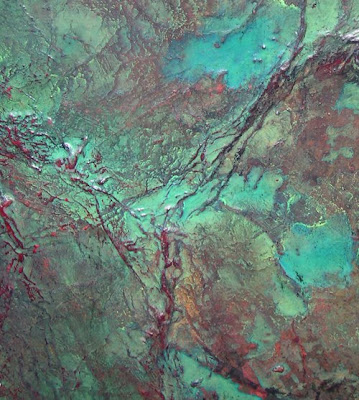 Random Aerial #1 with no city (detail 1)
Random Aerial #1 with no city (detail 1) Random Aerial #1 with no city (detail 2)
Random Aerial #1 with no city (detail 2)Above are some details and below is the 4 1/2' by 5' foot aerial that I mentioned from First Friday. This was the first painted aerial (after I’d started a couple of city aerials in fiber in 2002 and recently recombined them into this piece). I began the painted piece in 2003 while we were still living in Los Angeles.
Each of the aerials has a psychological and somewhat autobiographical component. The city pieces were a mapping of my immersion in a city the size of Ireland that is traversed almost solely by automobile. While in L.A., I drove all the time, every day and over large areas. On average, I drove about 50 miles each day and in multiple directions on side streets and freeways. After 8 years, I had the streets, the restaurants, the getaway drives, the routes to school and work and their many alternate routes memorized. So working with the labor-intensive fiber processes and with cutting and collage fit the psychological experience, if only to relive it to some extent… delays, dead ends, rerouting… all buried in this frenetic, consuming and inescapable energy.
The paintings however were part wish fulfillment and part unveiling – pulling back the skin of the city to uncover an imaginary expanse of unaltered desert ground and fantasized water. In the painting process, I draped fabric and paper over panel, laid it flat and let the paint and water settle into the hollows. Then I rubbed grease stick and oil pastel over the high points and repainted with acrylic. I repeated this process over several months before I set it aside for a couple of years and picked it up again recently with more applications of the same layering process.
With the painting, I was less interested in building representations or images on a ground or in showing my hand (as with the city fiber aerials) than I was in letting the organic processes of draping, pouring, drying and rubbing create a structure of the ground. As such, the painting became more sculptural while the fiber pieces more painterly.
As I mentioned in the First Friday post, this piece is difficult to light because of its multiple planes and hot spots. The viewer must be in constant motion around the piece to see all of it clearly – an effect I may use to other ends some day.
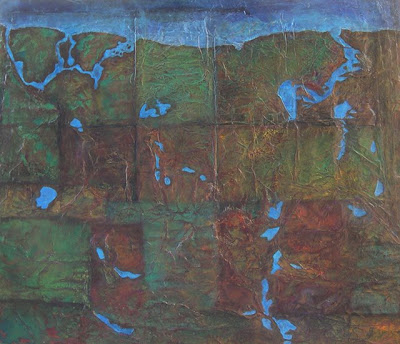 Random Aerial #1 (water, desert and ocean with no city), 2003-07
Random Aerial #1 (water, desert and ocean with no city), 2003-07
Flat Aerials
I've had a flu/cold for the last two weeks and haven't been able to spend much time in the studio. All I've been able to muster the energy for is my work at the museum and a couple of hours here and there before and after the museum work. Mostly, I've been working at home on some smaller pieces and sorting out what's left of my home studio.
Today I moved several things that had been piling up at home to the downtown studio, worked for a few hours there and took the photos below. They're a couple of the painted aerials I moved today. I started these in the fall of 2005 right after we moved to Knoxville from Los Angeles. That these were the first new pieces I started within a couple of months of moving to the new location is personally significant considering their pastoral, even agricultural, quality. At this point, they're still works-in-progress.
Note:I filled the unpainted parts digitally with pale blue to experiment with alternatives to the white of the unpainted gesso.
.jpg)
.jpg) Random Aerial #3 (vertical pastoral sketch) and Random Aerial #4 (horizontal pastoral sketch)
Random Aerial #3 (vertical pastoral sketch) and Random Aerial #4 (horizontal pastoral sketch)
These paintings explore my relationship to sites of city and country and to a "naturalized" view of the human imprint on the landscape. As most of my other work, these pieces play with ways of knowing a landscape: either through a sequenced / time-based relationship (as in walking, one foot / image in front of the other) or a spatial, holistic and mapped view. These pieces would be the mapped view. All this is nuanced by my personal experience of moving back to Appalachia from Los Angeles and the loss of the imagined relationship to "the country" from afar.
These aren't paintings in the usual sense as I used processes more akin to fiber dyeing than to mark-making or brush-work. First, I allowed the paint to move about on the panel in response to my controlled motions (similar to what I'd discovered earlier with dyeing and staining raw canvases). With this process, images emerge that are simultaneously random and patterned as with other dendritic forms. Upon seeing such forms emerge, the process made it easy for me to imagine I was as much a force of nature governed by physical parameters as a collection of trees, a leaf or a city like Los Angeles. My movements and thoughts constructed the same forms as a branching tree, a forking river, a vine of ivy, a clump of blood vessels, an interstate freeway system or a cancer.
Second in the process, I deliberately filled-in the spaces created between the randomness. This part of the process was very deliberate and opened the work up to choice, patterns and a different form of repetition.
I found the relationship between the precision and the fluidity to be meaningful during that time of transition. In fact, I find this work to be very personal as it reveals my thought processes and struggles at a time when I was trying to re-situate myself in a location that (in nostalgic recollection) I had believed to be familiar and, yet, was so utterly different than the city which I'd become accustomed and whose streets and freeways I knew so intimately.
Today I moved several things that had been piling up at home to the downtown studio, worked for a few hours there and took the photos below. They're a couple of the painted aerials I moved today. I started these in the fall of 2005 right after we moved to Knoxville from Los Angeles. That these were the first new pieces I started within a couple of months of moving to the new location is personally significant considering their pastoral, even agricultural, quality. At this point, they're still works-in-progress.
Note:I filled the unpainted parts digitally with pale blue to experiment with alternatives to the white of the unpainted gesso.
.jpg)
.jpg) Random Aerial #3 (vertical pastoral sketch) and Random Aerial #4 (horizontal pastoral sketch)
Random Aerial #3 (vertical pastoral sketch) and Random Aerial #4 (horizontal pastoral sketch)These paintings explore my relationship to sites of city and country and to a "naturalized" view of the human imprint on the landscape. As most of my other work, these pieces play with ways of knowing a landscape: either through a sequenced / time-based relationship (as in walking, one foot / image in front of the other) or a spatial, holistic and mapped view. These pieces would be the mapped view. All this is nuanced by my personal experience of moving back to Appalachia from Los Angeles and the loss of the imagined relationship to "the country" from afar.
These aren't paintings in the usual sense as I used processes more akin to fiber dyeing than to mark-making or brush-work. First, I allowed the paint to move about on the panel in response to my controlled motions (similar to what I'd discovered earlier with dyeing and staining raw canvases). With this process, images emerge that are simultaneously random and patterned as with other dendritic forms. Upon seeing such forms emerge, the process made it easy for me to imagine I was as much a force of nature governed by physical parameters as a collection of trees, a leaf or a city like Los Angeles. My movements and thoughts constructed the same forms as a branching tree, a forking river, a vine of ivy, a clump of blood vessels, an interstate freeway system or a cancer.
Second in the process, I deliberately filled-in the spaces created between the randomness. This part of the process was very deliberate and opened the work up to choice, patterns and a different form of repetition.
I found the relationship between the precision and the fluidity to be meaningful during that time of transition. In fact, I find this work to be very personal as it reveals my thought processes and struggles at a time when I was trying to re-situate myself in a location that (in nostalgic recollection) I had believed to be familiar and, yet, was so utterly different than the city which I'd become accustomed and whose streets and freeways I knew so intimately.
Wednesday, February 07, 2007
Downtown Fire
I was startled out of bed with an early morning phone call from a family member, "I don't mean to alarm you, but some historic buildings are on fire in downtown Knoxville and it looks like the building your studio is in could be one of them... and if not your building, then one very close by."
I had this instant moment of panic and then a horrible sinking feeling. My first formed thought was of Freida, my dressform... funny the things you want to save from a burning building.
I told Frank what was up, and we turned on the TV news and watched another of Knoxville's beautiful historic buildings being gutted by fire. So many buildings on the historic register are burned out or crumbling vacant.
The best we could make out from the TV was that the buildings on fire were on Jackson Ave, catty corner to my studio, which is on the corner of Jackson and Gay.
I had to leave by 9:30 for a museum tour, but went down to the studio after that – around 11:30. I had the crazy idea that I was going to work this afternoon, but big signs in huge letters had been posted on all the doors: Artists please go home! We are concerned that asbestos toxins are in the air.
I didn’t go in the building, but stayed in the area for about 30 minutes to take the pictures below. The fire was already under control (just smoldering) and the streets had been reopened. I was able to confirm that the damage was limited to the group of abandoned buildings I'd seen on TV. Scary thing was that cinders had flown off the fire and landed on the rooftop of the building directly across the street from us, but fortunately they were able to put that fire out before it ever got started.
I also saw cinders lining our building on the Jackson Ave side.
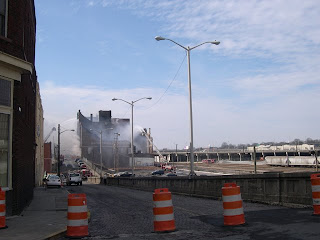 here's a view of the damage looking out from in front of our building... the building in the left edge of the picture is the one that had fiery cinders land on its roof
here's a view of the damage looking out from in front of our building... the building in the left edge of the picture is the one that had fiery cinders land on its roof
 here's some debris on Gay St just across the street from our building
here's some debris on Gay St just across the street from our building
 looking down on what's left from the Gay St bridge
looking down on what's left from the Gay St bridge
 our building, safe and secure
our building, safe and secure
 the buildings across the street, safe as well
the buildings across the street, safe as well
I had this instant moment of panic and then a horrible sinking feeling. My first formed thought was of Freida, my dressform... funny the things you want to save from a burning building.
I told Frank what was up, and we turned on the TV news and watched another of Knoxville's beautiful historic buildings being gutted by fire. So many buildings on the historic register are burned out or crumbling vacant.
The best we could make out from the TV was that the buildings on fire were on Jackson Ave, catty corner to my studio, which is on the corner of Jackson and Gay.
I had to leave by 9:30 for a museum tour, but went down to the studio after that – around 11:30. I had the crazy idea that I was going to work this afternoon, but big signs in huge letters had been posted on all the doors: Artists please go home! We are concerned that asbestos toxins are in the air.
I didn’t go in the building, but stayed in the area for about 30 minutes to take the pictures below. The fire was already under control (just smoldering) and the streets had been reopened. I was able to confirm that the damage was limited to the group of abandoned buildings I'd seen on TV. Scary thing was that cinders had flown off the fire and landed on the rooftop of the building directly across the street from us, but fortunately they were able to put that fire out before it ever got started.
I also saw cinders lining our building on the Jackson Ave side.
 here's a view of the damage looking out from in front of our building... the building in the left edge of the picture is the one that had fiery cinders land on its roof
here's a view of the damage looking out from in front of our building... the building in the left edge of the picture is the one that had fiery cinders land on its roof here's some debris on Gay St just across the street from our building
here's some debris on Gay St just across the street from our building looking down on what's left from the Gay St bridge
looking down on what's left from the Gay St bridge our building, safe and secure
our building, safe and secure the buildings across the street, safe as well
the buildings across the street, safe as well
Saturday, February 03, 2007
February First Friday and fiber aerial in progress
Last night was the First Friday art walk. The weather was cold and lousy, but lots of people showed up nonetheless. Met some great new folks and visited with old friends.
I’m still working on the big fiber aerial from last month and an aerial painting I started back in L.A. I also showed a new piece that uses the free-weaving process I’m inventing and hopefully perfecting.
Here’s the fiber aerial:
 Los Angeles Aerial #3: Psychogeography of the crazy quilt (in the fashion of Jackson Pollock)
Los Angeles Aerial #3: Psychogeography of the crazy quilt (in the fashion of Jackson Pollock)
The 3' x 4' piece is a collage of vintage fabrics, men's neckties and painted / dyed fabrics, machine and hand stitching.
I’m still working on the big fiber aerial from last month and an aerial painting I started back in L.A. I also showed a new piece that uses the free-weaving process I’m inventing and hopefully perfecting.
Here’s the fiber aerial:
 Los Angeles Aerial #3: Psychogeography of the crazy quilt (in the fashion of Jackson Pollock)
Los Angeles Aerial #3: Psychogeography of the crazy quilt (in the fashion of Jackson Pollock)The 3' x 4' piece is a collage of vintage fabrics, men's neckties and painted / dyed fabrics, machine and hand stitching.
Saturday, January 27, 2007
yarn p0rn, free-weaving, dyeing and painting
I have an aunt who has been thinning her fiber / fabric stash, which made me the lucky recipient of these colorful yarns:
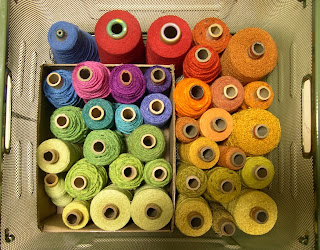
and some white ones for dyeing:
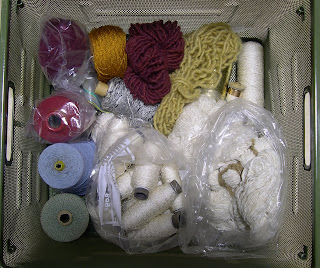
Similar to what I've done here (though this is a much smaller scale), I'll be "free-weaving," as I call it, these yarns into 3' x 4' aerials. Right now I'm dyeing strips of canvas and stretching them onto canvas stretchers to create the main structures of the weaving. Dendridic forms in leaves, trees and aerials really lend themselves to this process.
I've also been painting again, working mostly on a 4 1/2' by 5' aerial that I started in Los Angeles. This painting has sucked months from my life and I'm still struggling with the way it reflects light and creates hot spots. Lighting this thing evenly is near impossible because the surface has so many different planes. I've draped fabric and paper over wood panel and then dripped and rubbed it with paint. The textures are great and like the free-weaving appropiate to the subject matter, but the viewer has to be in constant motion around the painting to see all of it... curious effect I could use to other ends, I suppose.

and some white ones for dyeing:

Similar to what I've done here (though this is a much smaller scale), I'll be "free-weaving," as I call it, these yarns into 3' x 4' aerials. Right now I'm dyeing strips of canvas and stretching them onto canvas stretchers to create the main structures of the weaving. Dendridic forms in leaves, trees and aerials really lend themselves to this process.
I've also been painting again, working mostly on a 4 1/2' by 5' aerial that I started in Los Angeles. This painting has sucked months from my life and I'm still struggling with the way it reflects light and creates hot spots. Lighting this thing evenly is near impossible because the surface has so many different planes. I've draped fabric and paper over wood panel and then dripped and rubbed it with paint. The textures are great and like the free-weaving appropiate to the subject matter, but the viewer has to be in constant motion around the painting to see all of it... curious effect I could use to other ends, I suppose.
Sunday, January 14, 2007
Quote On Photography
The photographer is now charging real beasts, beleaguered and too rare to kill. Guns have metamorphosed into cameras in this earnest comedy, the ecology safari, because nature has ceased to be what it has always been – what people need protection from. Now nature – tamed, endangered, mortal – needs to be protected from people. When we are afraid we shoot. But when we are nostalgic, we take pictures.
Susan Sontag, On Photography
Susan Sontag, On Photography
Saturday, January 06, 2007
First Friday of the New Year
I’ve been feeling a bit low-energy lately, which kind of put a damper on my usual First Friday over-planning, over-prepping and over-working. And oddly, that turned out to be a good thing.
All I did to prep was buy the usual wine and snacks and show up 30 minutes before the event started. I didn't even hang any new work. The only piece that was on the wall was a 3’ x 4’ aerial grid that was pinned to my corkboards. I've been working on this fiber piece, in some form, for years. This thing has been constructed, deconstructed, reconstructed and recombined with other so many other pieces. It's kind of unbelievable the amount of history and labor in this piece, which shows... layers of neckties, dyed and painted fabrics, hand and machine-stitching, over-stitching, etc.
I was surprised to see how many people were blown-away by this piece. They wanted to know how it was done, where it was going, what it was, how I came up with the process...
One woman holding a toddler asked him, "Is this painted or sewn?"
"sewn"
"Did this take a little time or a lot of time?"
"laaadaaaa"
Here I was feeling a bit underachieving for not having any new work up, but exhausted enough not to be too bothered. So… I'm feeling really low-key, and everyone is coming in and getting really excited about this work, and they're leaving and collecting more people and dragging them into my studio because, "You just have to see this."
The conversations ranged from a geographer talking about mapping to a girl from Appalachia who moved to Los Angeles talking about her difficulties adjusting. She said things I'd said myself so many times about not being able to find her grounding through the concrete or solace without more than little glimpses of sky. Like us, she used to get away to Malibu so she could stand in the Santa Monica Mountains and look out over the ocean and experience expanse and the soothing vision of the horizon line.
So often, Frank and I tell ourselves that if we'd had more opportunities to get out of the city, we could have been content in L.A. But as it was, we just felt trapped and surrounded – which is what this particular aerial is about: complete immersion in a place the size of the entire country of Ireland and the density of... well, Los Angeles.
All I did to prep was buy the usual wine and snacks and show up 30 minutes before the event started. I didn't even hang any new work. The only piece that was on the wall was a 3’ x 4’ aerial grid that was pinned to my corkboards. I've been working on this fiber piece, in some form, for years. This thing has been constructed, deconstructed, reconstructed and recombined with other so many other pieces. It's kind of unbelievable the amount of history and labor in this piece, which shows... layers of neckties, dyed and painted fabrics, hand and machine-stitching, over-stitching, etc.
I was surprised to see how many people were blown-away by this piece. They wanted to know how it was done, where it was going, what it was, how I came up with the process...
One woman holding a toddler asked him, "Is this painted or sewn?"
"sewn"
"Did this take a little time or a lot of time?"
"laaadaaaa"
Here I was feeling a bit underachieving for not having any new work up, but exhausted enough not to be too bothered. So… I'm feeling really low-key, and everyone is coming in and getting really excited about this work, and they're leaving and collecting more people and dragging them into my studio because, "You just have to see this."
The conversations ranged from a geographer talking about mapping to a girl from Appalachia who moved to Los Angeles talking about her difficulties adjusting. She said things I'd said myself so many times about not being able to find her grounding through the concrete or solace without more than little glimpses of sky. Like us, she used to get away to Malibu so she could stand in the Santa Monica Mountains and look out over the ocean and experience expanse and the soothing vision of the horizon line.
So often, Frank and I tell ourselves that if we'd had more opportunities to get out of the city, we could have been content in L.A. But as it was, we just felt trapped and surrounded – which is what this particular aerial is about: complete immersion in a place the size of the entire country of Ireland and the density of... well, Los Angeles.
Tuesday, January 02, 2007
Joanna Staniszkis wearable art: The Linen Project
some beautiful pieces of wearable art
Click through the gallery to see all these great pieces... more interesting things on the rest of her website.
Click through the gallery to see all these great pieces... more interesting things on the rest of her website.
Subscribe to:
Posts (Atom)

